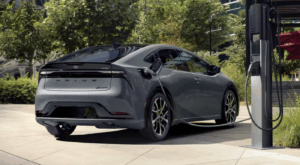A Tesla Powerwall can last up to 10 years. Its lifespan depends on usage, maintenance, and environmental factors.
The Powerwall is designed to provide efficient energy storage for homes. It stores solar energy and powers your home when needed. Understanding its lifespan helps in planning energy solutions. Many factors influence how long it lasts. These include the frequency of charging cycles and the conditions it’s exposed to.
Proper care and maintenance can extend its life. Regular checkups ensure optimal performance. With its durable design, the Powerwall is a reliable choice for sustainable energy. Knowing how long it lasts is crucial for long-term planning. It offers a practical solution for reducing reliance on the grid.

Credit: www.motortrend.com
Tesla Powerwall Overview
Tesla Powerwall offers reliable energy storage for homes, lasting up to 10 years with proper maintenance. Its lifespan varies based on usage and environmental factors, providing backup power during outages. Ideal for sustainable energy solutions, it helps reduce reliance on the grid.
Tesla Powerwall Overview The Tesla Powerwall is revolutionizing the way homes utilize solar energy. It’s a compact, sleek battery system designed to store energy for later use, offering independence from the grid. Imagine having a reliable power source at home that charges up when the sun is shining and keeps your lights on even when it’s not. ###Introduction To Powerwall
Tesla introduced the Powerwall to help homeowners manage their energy more efficiently. It’s a game-changer for anyone who wants to cut down on electricity costs. This battery system allows you to store excess solar energy generated during the day and use it when the sun goes down or during power outages. ###Key Features
The Powerwall boasts impressive features that make it a standout choice. Its sleek design fits seamlessly into any home, offering aesthetic appeal along with functionality. It’s also easy to install and maintain, making it a hassle-free addition to your energy management system. Another standout feature is its ability to integrate with the Tesla app. This app lets you monitor energy consumption in real-time, providing insights into how you can optimize usage. Imagine sitting in your living room and checking how much energy you’ve stored with just a few taps on your smartphone. Have you ever wondered how much energy goes to waste at home? With the Powerwall, you can track and minimize this wastage, making your home more energy-efficient. It’s not just about saving money; it’s about making smarter choices for a sustainable future. The durability of the Powerwall is noteworthy. It’s designed to last for years, providing reliable performance and peace of mind. So, how long will your Powerwall last? Most users find that it lasts well beyond the warranty period, often providing solid service for over a decade. When thinking about investing in a Powerwall, consider how it might change your daily life. What would it mean for you to have control over your energy use? The Powerwall gives you the tools to do just that, making it a valuable asset for any modern home. It’s a step towards a future where you have the power to manage your energy efficiently and responsibly.
Credit: ev-lectron.com
Battery Lifespan Basics
Tesla Powerwall typically lasts 10 to 15 years. Its lifespan depends on usage and environmental conditions. Proper care can extend its performance.
Understanding the lifespan of a Tesla Powerwall is crucial for anyone considering this energy storage solution. The Powerwall is a significant investment, and knowing how long it will last can help you make informed decisions about your home’s energy future. Let’s dive into the basics of battery lifespan and what you can expect from this innovative technology.Factors Affecting Lifespan
Several factors influence how long your Tesla Powerwall will last. One of the most critical is the number of charge and discharge cycles. The more you use your Powerwall, the more it ages. Temperature also plays a significant role. Extreme heat or cold can degrade battery performance over time. If you live in a region with harsh weather, consider how it might affect your Powerwall’s longevity. Usage habits are another key factor. If you regularly drain the battery to its minimum level, it might wear out faster. Keep these elements in mind when planning your Powerwall usage.Typical Lifespan Expectations
On average, a Tesla Powerwall is expected to last for about 10 to 15 years. This estimate depends on regular usage patterns and optimal conditions. It’s designed to retain a high level of efficiency throughout its lifespan. Tesla provides a warranty that covers the Powerwall for 10 years. This gives you peace of mind knowing you’re protected against early failures. However, with proper care, your Powerwall might even surpass these expectations. Have you ever thought about how long 10 years really is? It’s a decade of energy independence and savings. Imagine the impact on your electricity bills and the environment during that time. Incorporating a Powerwall into your home is more than just an investment; it’s a commitment to sustainable energy. Remember to consider these lifespan basics as you explore your energy options.Tesla Powerwall Specifications
The Tesla Powerwall is a popular home energy storage system. It stores energy from solar panels or the grid. Understanding its specifications helps in assessing its longevity.
These details are crucial for potential buyers. Knowing the specifications can guide decisions on energy needs.
Battery Composition
The Powerwall uses lithium-ion batteries. Lithium-ion is known for efficiency and durability. It has advanced technology for safety and reliability.
This composition allows for many charge cycles. It contributes to the Powerwall’s long lifespan. These batteries are widely used in various applications.
Energy Storage Capacity
The Powerwall has a capacity of 13.5 kWh. It can power essential appliances during outages. This capacity is suitable for most households.
It supports continuous power supply. Energy storage capacity is key to performance. Understanding this helps in planning energy usage.

Credit: www.motortrend.com
Usage Patterns Impact
The Tesla Powerwall’s lifespan is influenced by how you use it. Different usage patterns can significantly affect its longevity. Understanding these patterns can help optimize your Powerwall’s performance.
Daily Usage Scenarios
Daily energy consumption plays a crucial role in battery life. Frequent charging and discharging can wear out a battery faster. If you use the Powerwall for essential home functions, it may last longer. Consistent moderate use tends to preserve its lifespan. Heavy daily usage can lead to faster degradation. Balancing your energy needs can help prolong its effectiveness.
Peak Demand Considerations
Peak energy demand can strain your Powerwall. High power draw periods require more from the battery. Managing peak times can extend its lifespan. Using less energy during peak hours reduces wear and tear. Smart energy management can lower peak strain. Efficient use during these times maximizes Powerwall durability.
Environmental Factors
Tesla Powerwall’s lifespan depends on environmental factors like temperature and humidity. Optimal conditions enhance performance and longevity. Regular maintenance can ensure efficient energy storage and usage.
When considering how long a Tesla Powerwall will last, environmental factors play a crucial role. These elements can significantly affect battery performance and longevity. Understanding these factors can help you optimize your Powerwall’s lifespan and efficiency. Let’s dive into some key environmental aspects that impact your Powerwall.Temperature Effects
Temperature can be a game-changer for battery efficiency. Extreme heat can accelerate chemical reactions within the battery, potentially reducing its lifespan. Conversely, very cold temperatures might decrease its efficiency temporarily. You might have noticed your smartphone acting up in the heat or cold. The same principles apply to your Powerwall. Ideally, it should be kept in a controlled environment where temperatures are moderate.Humidity And Weather Impact
Humidity and weather conditions are another set of environmental factors to consider. High humidity levels can lead to condensation, which might affect the Powerwall’s electronic components. This could potentially lead to a decrease in efficiency or even damage over time. Consider installing your Powerwall in a sheltered area. A garage or covered outdoor space can protect it from direct exposure to harsh weather. Have you thought about how weather conditions in your area might impact your Powerwall’s longevity? Taking these environmental factors into account can make a significant difference in the lifespan of your Tesla Powerwall. Being mindful of where and how you install it will help ensure you get the most out of your investment.Maintenance And Care
Tesla Powerwall’s lifespan depends on usage and care. Proper maintenance can extend its life to over ten years. Regular checks and software updates help ensure efficient performance and longevity.
Maintaining your Tesla Powerwall is crucial for ensuring it provides reliable energy storage for years to come. Proper care can extend its lifespan and efficiency, offering you peace of mind. Let’s delve into some practical tips and insights to keep your Powerwall in top shape. ###Routine Maintenance Tips
Consistent upkeep can prevent potential issues with your Powerwall. Regularly check for software updates through the Tesla app to ensure your system is running on the latest version. This helps optimize performance and can even resolve minor glitches. Keep the area around your Powerwall clean and free from dust. Dust accumulation can affect its cooling system. Consider placing it in a well-ventilated area to promote airflow and avoid overheating. Check the Powerwall’s connections periodically. Ensure cables are secure and free from damage. If you notice any fraying or loose connections, contact a professional for assistance. ###Signs Of Wear And Tear
Being aware of wear and tear indicators can help you address issues before they become serious problems. Look out for unusual noises coming from the Powerwall, as these could signal internal issues. A decrease in efficiency or unexpected power outages might indicate that your Powerwall requires attention. Monitor its performance closely and compare it to previous months to spot anomalies. Visible physical damage such as cracks or dents should not be ignored. Even if the Powerwall seems to be working fine, such damages might compromise its integrity over time. In my experience, I noticed a slight drop in efficiency after a particularly hot summer. By ensuring proper ventilation and checking the connections, I was able to restore its performance. Have you noticed any signs of wear and tear in your system? Addressing them promptly can save you from future headaches. Regular maintenance and early detection of issues can make a significant difference. What are you doing today to ensure your Powerwall remains efficient tomorrow?Comparing With Other Batteries
Choosing the right battery for home energy storage is crucial. Many homeowners compare different options to find the best fit. The Tesla Powerwall is a popular choice. But how does it measure up against other batteries? Let’s dive into the differences and benefits.
Tesla Vs. Other Brands
Many brands offer home batteries. Tesla Powerwall stands out for its durability. It lasts longer than many competing batteries. Other brands may require replacement sooner. Tesla’s technology ensures reliable performance over time. This makes it a preferred choice for many homeowners.
Cost is another factor. Tesla Powerwall is competitively priced. It offers value for its longevity and capacity. Some other brands might be cheaper initially. But their shorter lifespan can lead to higher long-term costs. Tesla’s efficiency helps save money in the long run.
Advantages Of Tesla Powerwall
Tesla Powerwall offers seamless integration with solar panels. This enhances its appeal for eco-conscious users. It also provides backup during power outages. This feature ensures homes remain powered even when the grid fails.
Installation is straightforward. Tesla offers professional support to ensure proper setup. This contrasts with some other batteries. They might require more complex installation procedures. Tesla Powerwall’s user-friendly approach is a big advantage.
Monitoring energy use is simple with Tesla’s app. Users can track consumption and optimize usage. This helps in managing energy bills effectively. Other batteries might lack such advanced monitoring features. This sets Tesla apart in terms of convenience.
Maximizing Powerwall Lifespan
Extending the lifespan of a Tesla Powerwall is essential for efficient energy use. Proper care ensures you get the most out of your investment. It’s about using best practices and technology to keep the Powerwall running smoothly. This can lead to significant savings over time.
Best Practices For Longevity
Regular maintenance is vital for a long-lasting Powerwall. Keep the battery in a cool, dry place. Extreme temperatures can affect its performance. Avoid placing it in direct sunlight or near heat sources. Clean the Powerwall periodically to prevent dust buildup.
Proper charging habits can also extend its life. Avoid frequent deep discharges. Charge it regularly and maintain a stable energy input. This approach helps in reducing wear and tear over time.
Monitoring And Management Tools
Use Tesla’s app to monitor your Powerwall. The app provides insights into energy usage and battery health. This helps in making informed decisions about energy consumption. Set alerts for unusual activity or low battery levels.
Smart management tools can optimize Powerwall performance. These tools analyze patterns and suggest adjustments. They can help reduce stress on the battery. This proactive approach can significantly extend its lifespan.
Future Developments
As technology continues to evolve at a rapid pace, the future of Tesla Powerwall promises exciting developments. You might wonder what advancements are on the horizon for this already impressive energy storage solution. Let’s dive into the potential future enhancements and upcoming features that could redefine how we view energy storage.
Technological Advancements
Imagine a world where your Powerwall is smarter and more efficient than ever. Tesla is continuously working on improving the battery technology to increase lifespan and storage capacity. You can expect enhancements in battery chemistry that will make the Powerwall last longer and perform better.
One possible advancement is the integration of AI to optimize energy consumption. This could allow your Powerwall to predict your energy needs and adjust accordingly. How would you feel knowing your home energy system is not only storing power but also smartly managing it?
Upcoming Models And Features
Tesla is known for pushing boundaries, and future models of the Powerwall are expected to follow suit. Rumors suggest new designs could be more compact, making them easier to fit into various home setups. Consider how a smaller unit could change your installation options.
New features might include enhanced connectivity with smart home systems. This would allow seamless integration with other devices, creating an interconnected energy ecosystem. Imagine receiving alerts on your smartphone about energy usage, helping you make informed decisions.
As you look forward to these developments, consider how they could impact your energy independence. Will these advancements encourage more homes to embrace solar power and energy storage? The future is bright, and it’s exciting to think about the possibilities that lie ahead.
Frequently Asked Questions
What Is The Life Expectancy Of The Tesla Powerwall?
The Tesla Powerwall has an estimated life expectancy of 10 to 15 years. Its warranty covers 10 years, ensuring reliable energy storage. Regular maintenance can extend its lifespan. It’s designed to withstand daily use and environmental conditions, providing sustainable home energy solutions.
How Long Will A Tesla Powerwall Power A House?
A Tesla Powerwall can power a house for about 7 to 10 hours with a typical energy consumption. Factors like usage, number of Powerwalls, and home energy needs affect duration. For longer backup, multiple Powerwalls may be required.
How Efficient Is A Tesla Powerwall After 10 Years?
A Tesla Powerwall typically retains about 70-80% of its original capacity after 10 years. Its efficiency depends on usage and maintenance. Regular monitoring and proper care can help maintain its performance. Tesla’s warranty covers capacity retention, ensuring long-term reliability for homeowners.
How Many Years Will A Tesla Powerwall 3 Last?
Tesla Powerwall 3 typically lasts around 10 to 15 years. Battery lifespan depends on usage and environmental conditions. Regular maintenance can extend its life. Investing in a Powerwall offers long-term energy storage solutions. Ensure professional installation for optimal performance and longevity.
Conclusion
A Tesla Powerwall offers reliable energy storage. Its lifespan depends on use and conditions. Typically, it lasts 10 to 15 years. Regular maintenance helps extend its life. Monitor battery health regularly. An efficient choice for home energy needs. Investing in one can provide long-term benefits.
Consider your energy habits and environment. This helps in making an informed decision. Enjoy sustainable energy with peace of mind. A smart step toward a greener future.


